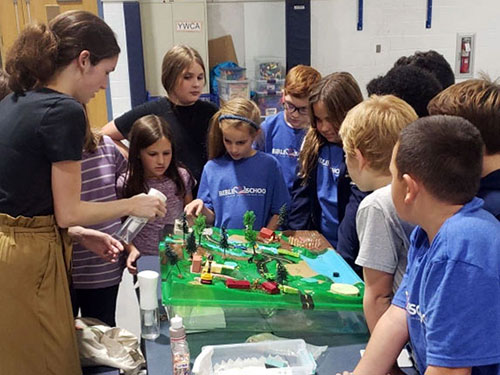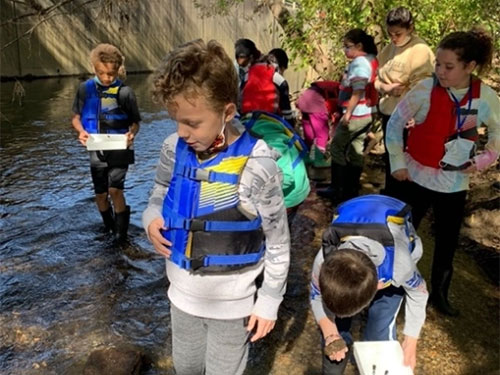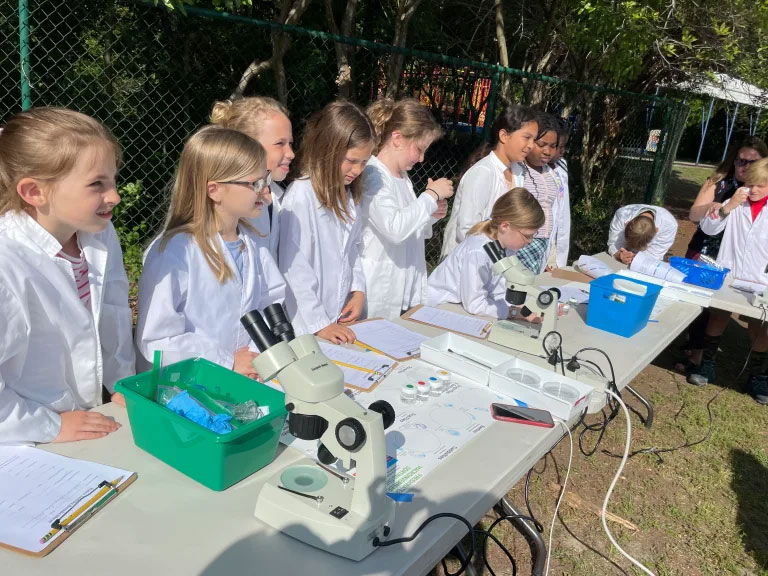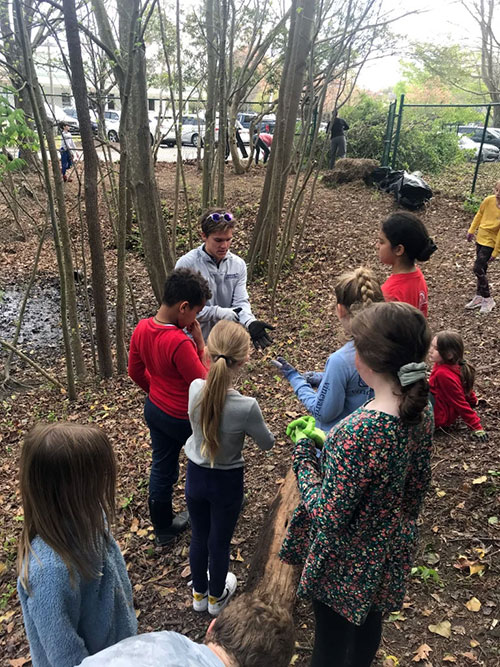What is MWEE?
The MWEE (pronounced Me-Wee) consists of four essential elements that describe “what students do.” These elements promote a learner-centered approach that emphasizes the role of the student in actively constructing meaning from the learning experiences. The order of the elements depends on project design and is not always linear. For example, some elements, such as Synthesis and Conclusions, should occur repeatedly throughout the MWEE.
Issue Definition
 Teachers and students work together to define a locally relevant environmental issue or phenomenon affecting watershed, coastal, or ocean ecosystems. Throughout the MWEE, students focus on a driving question that guides their inquiry and investigations of the defined issue and leads to stewardship actions. During Issue Definition, students learn about the issue through classroom instruction and are actively involved in planning and conducting background research and investigations focused on understanding the driving question (e.g., making observations and/or measurements; carrying out investigations; talking to experts or relevant stakeholders; reviewing credible resources; reviewing current environmental policies or community practices; exploring models; using tools). Students also reflect on personal and public values and perspectives related to the driving question. Teachers should ensure that the driving question is open-ended, relevant to the students’ lives, and meets their learning objectives.
Teachers and students work together to define a locally relevant environmental issue or phenomenon affecting watershed, coastal, or ocean ecosystems. Throughout the MWEE, students focus on a driving question that guides their inquiry and investigations of the defined issue and leads to stewardship actions. During Issue Definition, students learn about the issue through classroom instruction and are actively involved in planning and conducting background research and investigations focused on understanding the driving question (e.g., making observations and/or measurements; carrying out investigations; talking to experts or relevant stakeholders; reviewing credible resources; reviewing current environmental policies or community practices; exploring models; using tools). Students also reflect on personal and public values and perspectives related to the driving question. Teachers should ensure that the driving question is open-ended, relevant to the students’ lives, and meets their learning objectives.
Outdoor Field Experiences
 Students participate in multiple outdoor field experiences sufficient to investigate the driving question. Within appropriate safety guidelines, students are actively involved in planning and conducting the field investigations, including developing supporting questions to explore the driving question in the field. During field experiences, students use their senses to make first-hand observations, gain experience using equipment or technology to collect data or measurements, and conduct experiments necessary to answer their supporting questions and inform student stewardship actions.
Students participate in multiple outdoor field experiences sufficient to investigate the driving question. Within appropriate safety guidelines, students are actively involved in planning and conducting the field investigations, including developing supporting questions to explore the driving question in the field. During field experiences, students use their senses to make first-hand observations, gain experience using equipment or technology to collect data or measurements, and conduct experiments necessary to answer their supporting questions and inform student stewardship actions.
Outdoor field experiences can take place on school grounds or at locations in close proximity to schools, such as streams or city parks. They can also take place at off-site locations such as state parks, wildlife refuges, or education centers that are staffed by experts and have access to field education materials and facilities. A range of individuals, including teachers, environmental educators, natural resource professionals, or trained volunteers, can help facilitate field experiences and ensure a safe outdoor learning environment. However, facilitators should co-develop and co-teach instruction with teachers so that field experiences are supportive of their learning objectives and/or academic standards.
Outdoor field experiences allow students to interact with their local environment and contribute to learning in ways that traditional classroom or laboratory settings may not. Projects should employ methodologies used in fieldwork so students learn how to work in a natural uncontrolled environment. Students who have opportunities to learn in, thrive in, and appreciate the outdoors can become informed and engaged champions for our natural resources.
Synthesis and Conclusions
 Students identify, synthesize, and apply evidence from their investigations to draw conclusions about the defined issue or phenomenon. They demonstrate understanding of their investigations and conclusions through communication to a variety of audiences such as other classrooms, schools, parents, or the community.
Students identify, synthesize, and apply evidence from their investigations to draw conclusions about the defined issue or phenomenon. They demonstrate understanding of their investigations and conclusions through communication to a variety of audiences such as other classrooms, schools, parents, or the community.
Synthesis and conclusions is an iterative process and should happen regularly throughout the MWEE. Throughout the process, teachers dedicate time for students to reflect on their experiences and investigations in relation to the defined issue or phenomenon. Teachers should facilitate students sharing their conclusions with each other. Students’ conclusions should be used to help develop stewardship actions.
Stewardship Actions
 Students identify and implement a stewardship action as a solution that directly addresses the defined issue or phenomenon within their school, town, neighborhood, or community. Students are actively engaged and, to the extent possible, drive the decision-making, planning, and implementation of the stewardship action while teachers play a facilitation role by forming groups, moderating, and answering questions. Students reflect on the action and determine the extent to which the action successfully addressed the issue or phenomenon.
Students identify and implement a stewardship action as a solution that directly addresses the defined issue or phenomenon within their school, town, neighborhood, or community. Students are actively engaged and, to the extent possible, drive the decision-making, planning, and implementation of the stewardship action while teachers play a facilitation role by forming groups, moderating, and answering questions. Students reflect on the action and determine the extent to which the action successfully addressed the issue or phenomenon.
This element allows students to understand that they personally have the power to bring about change to environmental issues, take action to address these issues at the personal or societal level, and understand the value of that action. This can instill confidence in students and can contribute to students becoming environmental stewards in their communities.
Stewardship actions can take many forms and may fall into the following categories:
- Watershed Restoration or Protection: actions that assist in the recovery or preservation of a watershed or related ecosystem that has been degraded, damaged, or destroyed (e.g., plant or restore protective vegetation/trees; restore a local habitat; remove invasive plants; clean up litter at local beaches, parks, or school grounds; develop a school garden, natural history area, community garden, or other sustainable green space; install rain gardens to help manage stormwater).
- Everyday Choices: actions that reduce human impacts on watersheds and related ecosystems and offer ways to live more sustainably (e.g., reduce/reuse/recycle/upcycle; monitor and save water in the face of potential drought or reduction in water availability; compost food or yard waste; research and implement energy efficient strategies or energy alternatives at school and/or at home).
- Community Engagement: actions that inform others about how to address community-level environmental issues (e.g., give presentation to local organizations; organize community events; record or broadcast public service announcements; share information on social media; post flyers in community; share posters at community events/fairs/festivals; mentoring).
- Civic Action: actions that identify and address issues of public concern. Students acting alone or together to protect public values or make a change or difference in a student’s school, town, neighborhood, or community (e.g., present to school board or school principal; attend, speak, or present at town meetings; write or meet with decision makers/elected officials of a students’ school, town, neighborhood, or community).
The information on this page is directly from NOAA’s website.